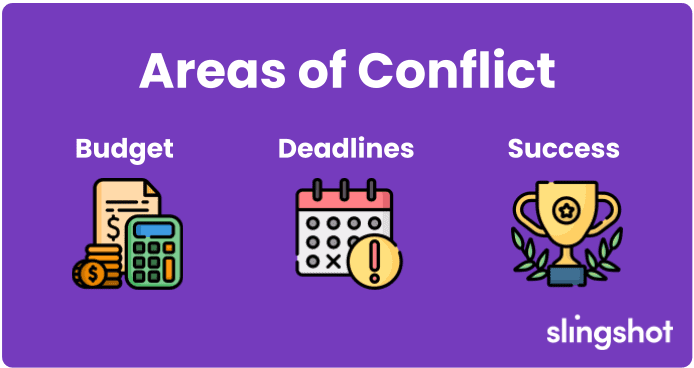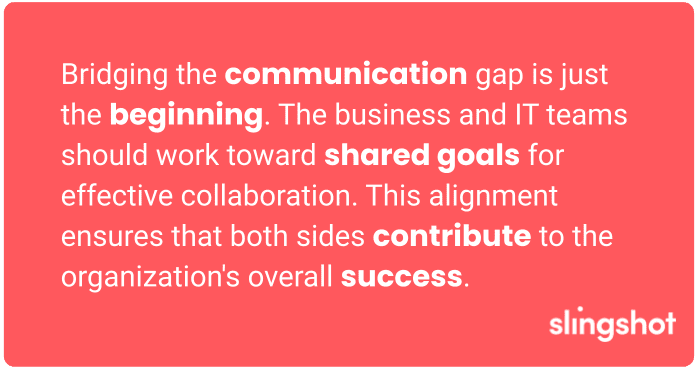Think about some of the biggest rivalries in pop culture, like Batman and The Joker, Gandalf and Saruman, and Luke Skywalker and Darth Vader. These famous duos are known for their epic clashes, each representing opposing ideals and values.
In the business world, we often see a similar dynamic between the operations side of a company and the IT/Tech side. Just like our favorite characters, these two groups can sometimes appear to be at odds, each with their agendas, priorities, and ways of doing things.
But what if, just like in those blockbuster movies and epic sagas, we found a way for both sides to unite, united by a common goal? Imagine a world where business and IT work together, leveraging their unique strengths to drive innovation and success. It sounds like a happy ending worth striving for, doesn’t it?
In this blog, we’ll explore how to bridge the gap between an organization’s business and IT sides, turning potential conflicts into opportunities for collaboration.
Summary
- The common conflicts that arise between business and IT and why they happen
- Effective communication strategies to break down barriers
- How to align goals and priorities for a unified approach
- Building mutual respect and understanding through practical steps
- Creating a unified culture that celebrates joint success
Understanding the Divide
Before we can start bridging the gap, it’s essential to understand where the divide comes from.
Areas of Conflict
First, what are the battles you’re most likely seeing?
Budget
A common area of tension is the budget. Business leaders often view the IT department as a cost center, focusing on controlling expenses. However, IT professionals see investments in technology as vital for the company’s growth, security, and long-term success. This difference in perspective can lead to disagreements over spending priorities, with business leaders emphasizing cost-efficiency and IT advocating for essential technological advancements.
Deadlines
Deadlines are another frequent point of contention. Business teams often face tight deadlines due to market demands and the need to stay competitive. They seek quick product launches to seize market opportunities and meet customer expectations. In contrast, IT teams prioritize building robust systems, ensuring that decisions are well thought out, and laying a solid foundation for future developments. It’s about way more than testing. It’s about building tech properly, laying a solid foundation, and not rushing through decisions.
Success
Finally, business and IT teams often have different ideas about success. Business leaders typically focus on quantitative metrics such as revenue, market share, and customer acquisition. On the other hand, IT professionals value the quality and stability of systems, security, and long-term sustainability. These differing viewpoints can lead to misunderstandings and make it challenging to align on common goals.

The Root Causes
Now, how did we get to the battlefield in the first place? Understanding the underlying causes of misunderstandings can help bridge the gap between business and IT teams.
Different Viewpoints
Business and IT teams often have different focuses. Business teams typically emphasize market needs, financial metrics, and customer satisfaction, aiming to drive growth and meet customer demands. IT teams, meanwhile, concentrate on technical feasibility, system integrity, and long-term sustainability, ensuring that the infrastructure supports these business goals. These different priorities can sometimes lead to misunderstandings, as each side may not fully appreciate the other’s perspective.
Communication Barriers
Communication challenges often arise due to differences in terminology and language used by business and IT teams. Technical jargon can be confusing for non-technical team members, and similarly, business terminology may not always be clear to those on the IT side. Bridging this gap involves using clear, accessible language and ensuring that all team members understand the context and relevance of discussions.
Work Culture
Business and IT departments often operate at different paces and with varying approaches. Business environments are frequently fast-paced, focusing on rapid decision-making and achieving targets to stay competitive. In contrast, IT teams may adopt a more methodical and process-oriented approach, emphasizing thorough planning and careful implementation. Recognizing and valuing these different work styles can foster better collaboration and mutual respect.
Bridging the Communication Gap
Effective communication is critical to overcoming misunderstandings and aligning both sides. Misunderstandings can quickly escalate conflicts. Clear, consistent communication helps ensure that everyone is on the same page.
Strategies for Effective Communication
So, to improve communication, we’ll need a strategy to get there.
Mutually Agreed Upon Deadlines and Deliverables
Establishing mutually agreed-upon deadlines and deliverables is a key strategy for fostering effective communication between business and IT teams. This approach involves both sides setting realistic timelines and defining clear deliverables, ensuring that expectations are aligned and understood.
Regular Meetings and Updates
Schedule regular check-ins for updates and project discussions to improve communication between business and IT teams. Structured meetings allow open dialogue, alignment of efforts, issue addressing, and informed decision-making. Regular updates prevent miscommunication and keep everyone informed, fostering collaboration and shared responsibility.
Using Common Language
Keep communication simple by using precise language that everyone can understand. Avoid technical jargon, tricky acronyms, and industry-specific slang, focusing on the practical implications and relevance to overall business objectives. This tip ensures better understanding and cooperation across teams.
Encouraging Open Feedback and Active Listening
Creating a comfortable environment where team members can freely share their thoughts and concerns is vital for effective communication and collaboration. Encourage open feedback by inviting team members to voice their opinions, ask questions, and express worries. Practice active listening to ensure that feedback is constructive and valuable. By fostering a culture of open feedback and active listening, teams can address issues more effectively and harmoniously work together.
Tools and Techniques
Strategy in place, check! Let’s make it even more similar with some tools and tricks.
- Collaboration Platforms: Tools like Slack or Microsoft Teams can facilitate real-time communication and keep everyone connected.
- Project Management Tools: Platforms like Jira or Asana help track progress and ensure transparency in project management.
- Cross-Functional Workshops: Regular workshops and training sessions can help team members understand each other’s roles and challenges.
Aligning Goals and Priorities
Like all departments, it’s important for everyone to have the same goals to work well together. Business and IT should both understand and support the company’s overall objectives. Having a common purpose brings everyone together!

Steps to Align Goals
Bridging the communication gap is just the beginning. The business and IT teams should work toward shared goals for effective collaboration. This alignment ensures that both sides contribute to the organization’s overall success.
Joint Planning Sessions
It’s important to involve business and IT teams in planning. Bringing key stakeholders from each side together allows for a comprehensive discussion about the company’s strategic objectives and the role each team plays in achieving them. This joint planning fosters a sense of ownership and ensures that both teams are committed to the same vision and objectives.
Setting Common Objectives and KPIs
Setting shared goals and KPIs aligns business and IT teams, making tracking progress and collaborating easier. Regular reviews help adapt to changing business and market conditions.
Encouraging Cross-Departmental Projects
Support cross-departmental projects that bring together business and IT teams to foster teamwork and mutual understanding. Collaborative efforts can lead to innovative solutions, improved processes, and a more robust organizational culture. Involving both sides in joint initiatives helps break down barriers and encourages a more integrated approach to problem-solving and project execution. Recognizing and celebrating the success of these projects further reinforces the value of teamwork and collaboration.
Building Mutual Respect and Understanding
It’s crucial to create an environment of respect and understanding for effective long-term teamwork. It’s also crucial to appreciate and respect everyone’s different contributions. Let’s celebrate wins together and credit all team members for their hard work.
Activities to Build Trust and Teamwork
Trust fall time! Just kidding…?
Cross-Training Programs
Cross-training helps business and IT teams understand each other’s roles and challenges. It fosters empathy and appreciation, enhances individual skills, and creates a more collaborative work environment.
Team-Building Exercises
Another fantastic way to unite the business and IT teams is by organizing team-building activities. These events are a great way to get everyone to bond and build stronger relationships in a fun and relaxed environment. From solving puzzles in escape rooms to more laid-back gatherings, team-building exercises can strengthen the team.
Job Shadowing Opportunities
Job shadowing allows employees to spend a day learning about different roles within the organization. For example, a business team member might shadow an IT professional to gain insights into technical problem-solving. In contrast, an IT employee might shadow a business colleague to understand market strategies. This insight helps foster understanding and respect across teams, leading to more effective collaboration.
Creating a Unified Culture
Having a strong team culture is vital to successful teamwork. Good leaders are essential in encouraging unity and teamwork. They should lead by showing how important teamwork and respect are.
Developing a Unified Company Culture
But great culture doesn’t happen at the flip of a switch. You’ll need to start small and grow into a unified culture.
Shared Values and Vision
Establishing and promoting shared values and a common vision is crucial for creating a unified culture within an organization, fostering a sense of collective purpose, and breaking down departmental silos to encourage a more cohesive and collaborative approach to achieving business success.
Inclusive Decision-Making Processes
Involving business and IT team members in decision-making is crucial for considering diverse perspectives. This collaborative approach can lead to more innovative and effective solutions by combining strategic business insights with technical expertise. Encouraging open dialogue and creating joint task forces for critical projects are practical ways to implement inclusive decision-making, resulting in enhanced decision quality and stronger inter-departmental bonds.
Celebrating Joint Successes
Recognizing and celebrating achievements resulting from collaboration reinforces the value of teamwork. Acknowledging joint efforts and successes with formal awards, casual outings, or mentions in company meetings is essential. These celebrations boost morale and encourage continued teamwork. Publicly acknowledging all team members’ contributions builds a culture of appreciation and reinforces the idea that success is a collective effort.

Benefits of a Unified Culture
A unified culture can lead to:
- Increased innovation by fostering an environment where diverse ideas are encouraged and valued.
- Better problem-solving through collaborative efforts that leverage all team members’ unique strengths and perspectives.
- Enhance employee satisfaction by creating a workplace where everyone feels appreciated and integral to the company’s success.
When everyone feels valued and included, they are more likely to contribute their best efforts and ideas, driving the organization forward.
Conclusion
We’ve talked about how business and IT can clash and how important it is to bring them together through good communication, shared goals, and respect. We’ve also mentioned how leaders can create a unified culture.
If you’re in charge, you should take steps to bring business and IT closer to your company. Use our ideas and get your teams to work together towards the same goal.
When business and IT work together, the potential for growth and success is enormous. By promoting collaboration and respect, we can turn conflicts into opportunities for innovation and success. Let’s aim for a positive outcome where everyone comes out on top.

Written by: Savannah Cherry
Savannah is our one-woman marketing department. She posts, writes, and creates all things Slingshot. While she may not be making software for you, she does have a minor in Computer Information Systems. We’d call her the opposite of a procrastinator: she can’t rest until all her work is done. She loves playing her switch and meal-prepping.

Edited by: David Galownia
David excels at propelling Slingshot towards their goals and oversees the strategic direction of the company. He’s been described as ‘intense, driven, caring, and passionate’ both at work and play. At work, he enjoys watching his team explore, imagine, and reinvent to do the best by their clients. At play, he drives Karts at insanely high speeds and scares his wife half to death. It’s all or nothing. Which means he gives it all.




